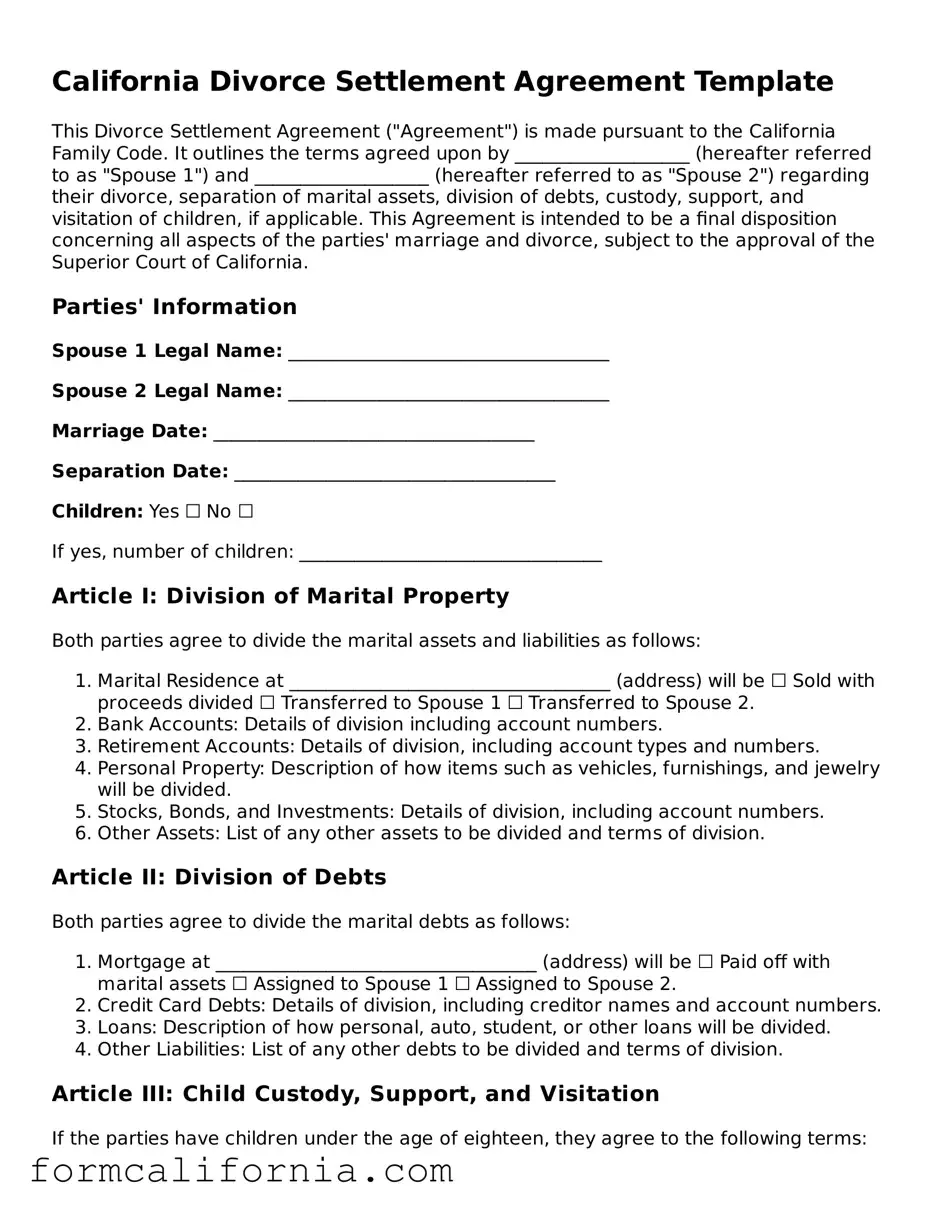California Divorce Settlement Agreement Template
This Divorce Settlement Agreement ("Agreement") is made pursuant to the California Family Code. It outlines the terms agreed upon by ___________________ (hereafter referred to as "Spouse 1") and ___________________ (hereafter referred to as "Spouse 2") regarding their divorce, separation of marital assets, division of debts, custody, support, and visitation of children, if applicable. This Agreement is intended to be a final disposition concerning all aspects of the parties' marriage and divorce, subject to the approval of the Superior Court of California.
Parties' Information
Spouse 1 Legal Name: ___________________________________
Spouse 2 Legal Name: ___________________________________
Marriage Date: ___________________________________
Separation Date: ___________________________________
Children: Yes ☐ No ☐
If yes, number of children: _________________________________
Article I: Division of Marital Property
Both parties agree to divide the marital assets and liabilities as follows:
- Marital Residence at ___________________________________ (address) will be ☐ Sold with proceeds divided ☐ Transferred to Spouse 1 ☐ Transferred to Spouse 2.
- Bank Accounts: Details of division including account numbers.
- Retirement Accounts: Details of division, including account types and numbers.
- Personal Property: Description of how items such as vehicles, furnishings, and jewelry will be divided.
- Stocks, Bonds, and Investments: Details of division, including account numbers.
- Other Assets: List of any other assets to be divided and terms of division.
Article II: Division of Debts
Both parties agree to divide the marital debts as follows:
- Mortgage at ___________________________________ (address) will be ☐ Paid off with marital assets ☐ Assigned to Spouse 1 ☐ Assigned to Spouse 2.
- Credit Card Debts: Details of division, including creditor names and account numbers.
- Loans: Description of how personal, auto, student, or other loans will be divided.
- Other Liabilities: List of any other debts to be divided and terms of division.
Article III: Child Custody, Support, and Visitation
If the parties have children under the age of eighteen, they agree to the following terms:
- Legal Custody: ☐ Joint ☐ Sole to Spouse 1 ☐ Sole to Spouse 2
- Physical Custody: ☐ Joint ☐ Primary with Spouse 1 ☐ Primary with Spouse 2
- Visitation Schedule: Details of the visitation schedule, including holidays, summers, and special occasions.
- Child Support: Details of the child support agreement, including amount, frequency, and duration of payments.
- Health Insurance: Description of who will provide and pay for the children's health insurance.
- Education Expenses: Agreement on how educational expenses will be shared.
- Other: Any additional terms related to child welfare.
Article IV: Spousal Support
☐ Spouse 1 ☐ Spouse 2 will pay spousal support to the other. Details of the spousal support agreement, including amount, frequency, and duration of payments.
Article V: Miscellaneous
This Agreement constitutes the entire agreement between the parties relating to its subject matter and supersedes all prior or contemporaneous agreements, understandings, representations, or communications between the parties. Any amendments to this Agreement must be in writing and signed by both parties.
Both parties affirm that they have entered into this Agreement voluntarily, without any duress or undue influence, and with a full understanding of its terms and conditions.
Executed this _____ day of _______________, 20____.
Signature of Spouse 1: ___________________________________
Signature of Spouse 2: ___________________________________
Notary Public: ___________________________________
